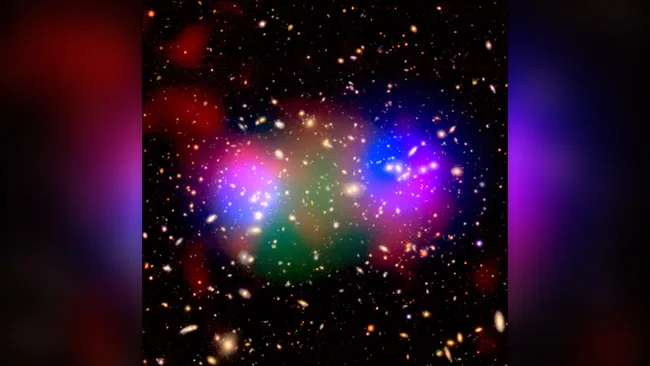New Study Suggests the Existence of a “Dark Mirror” Universe Within Our Own, Where Atom Formation Didn’t Occur
The invisible substance called dark matter remains one of the biggest mysteries in cosmology. Perhaps, a new study suggests, this strange substance arises from a ‘dark mirror universe’ that’s been linked to ours since the dawn of time.
What if the world of dark matter was a mirror of our own, just with a broken set of rules? That might explain why dark matter appears to be so abundant yet invisible, a new theory suggests.
Dark matter is the mysterious, unknown substance that seems to make up the bulk of all the mass in the universe; for every 2 pounds (1 kilogram) of regular matter, there’s roughly 10 pounds (5 kg) of dark matter. It doesn’t interact with light or normal matter. The only way scientists can detect it is through its subtle gravitational influence on normal matter, such as the motions of stars within galaxies and the growth of super-large structures in cosmic time.
It might be easy to think that because matter and dark matter operate with different rules, one would be totally dominant over the other. But despite having wildly different properties, the amounts of normal matter and dark matter are still in the same ballpark. That seems like a strange coincidence. To explain this, scientists proposed there could be some sort of hidden link between them. They published their research Jan. 22 on the preprint journal arXiv.
The researchers posited that for every physical interaction in normal matter, there’s a mirror of it in the world of dark matter. This would be a new kind of symmetry in nature, connecting the normal and dark matter worlds, the researchers said.
This symmetry would help explain why dark matter and regular matter have roughly the same abundances.

The researchers have highlighted another peculiar coincidence in their paper. In the realm of normal matter physics, a neutron and proton possess nearly identical masses, allowing them to combine and create stable atoms. If a proton were slightly heavier, it would quickly decay, rendering atom formation impossible. In a hypothetical scenario, the universe would be filled with unbound neutrons.
The researchers propose that this alternate, disrupted universe could exist in the dark matter mirror image of our own. Through a unique set of physical laws, a proton in this mirror universe might have a mass similar to that of a neutron. Consequently, the “dark proton” could disintegrate, leaving behind a collection of “dark neutrons” — known to us as dark matter.
Although this mirror model permits complex interactions among dark matter particles, such as dark atoms, dark chemistry, and a dark periodic table of elements, the researchers caution against excessive interaction. If dark matter interacts extensively with itself, it would clump together more than current scientific understanding suggests. Therefore, the majority of dark matter must remain relatively simple — a mass of unconnected, neutral particles.
These additional interactions, which could serve as a contrasting reflection of our chemical realm, have the potential to allow future scientists to experiment with this hypothesis. During the early stages of the universe, ordinary matter underwent nucleosynthesis, resulting in the formation of the first elements within a nuclear plasma. If this novel concept holds true, it suggests that a parallel nucleosynthesis process occurred within dark matter. In the tumultuous days of the universe’s infancy, pathways may have emerged between these two realms, enabling them to mutually influence each other.
By meticulously measuring the rate at which elements are formed – a task that upcoming cosmological observatories aspire to accomplish – scientists may uncover evidence supporting one of these pathways and gain a glimpse into the enigmatic mirror dark universe.
This article is republished from livescience under a Creative Commons license. Read the original article.
Do not forget to share your opinion with us to provide you with the best posts !



0 Comments